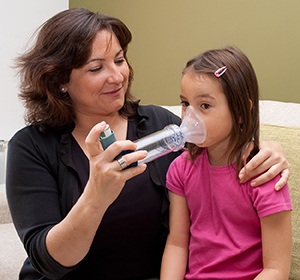Your Child’s Asthma: Taking Control
Your Child’s Asthma: Taking Control

The benefits of control
A child whose asthma is in control can do all of the things other children do. He or she will:
Be able to play with other kids and take part in sports
Be able to sleep well. This means more energy for school and play.
Miss fewer school days--and you’ll miss fewer workdays.
Asthma symptoms
Some children have symptoms often (persistent asthma). Others have symptoms once in a while (intermittent asthma). Know your child’s pattern of symptoms.
Mild to moderate asthma symptoms
Talk with your child’s healthcare provider about what to do when any of these symptoms occur:
Coughing, especially at night
Getting tired or out of breath easily
Wheezing (a whistling noise when breathing out)
Chest tightness
Fast breathing when at rest
Severe asthma symptoms
You should have an Asthma Action Plan that tells you what actions to take based on your child's symptoms. If you don't have an action plan, talk with your child’s healthcare provider about getting one. If you do have an action plan, review it with the provider once in a while to ensure it is up to date.
Call your child’s healthcare provider right away if your child has any of these symptoms:
Very fast or hard breathing
Sinking in between the ribs and above and below the breastbone (chest retractions)
If you or your child monitor asthma with peak flow readings, a peak flow less than 50% of your child's personal best
Call 911 right away if your child has any of these symptoms:
Unable to walk or talk
Lips or fingers turning blue
Your child seems in severe distress
Is your child’s asthma controlled?
If you answer yes to any of the questions below, your child’s asthma may not be in control. Work with your child’s healthcare provider to make changes to his or her treatment plan. Discuss any problems that make it hard for you or your child to stick to the plan.
Does your child need to use his quick-relief inhaler more than 2 times a week (other than before exercise)?
Does your child wake up at night with symptoms more than 2 times a month?
Does your child have trouble doing regular, daily activities more than twice per week?
What you can do
Make sure your child has an Asthma Action Plan. Review it once in a while with your child’s healthcare provider.
Understand your child’s treatment plan.
Know how to use each of your child’s medicines.
Know what makes your child’s asthma or triggers worse and how to help your child control or avoid them. If respiratory infections are triggers, use quick-relief medicines, as instructed, when your child begins to have symptoms.
Know your child's flare-up symptoms. Teach your child how to get help when a flare-up occurs. Be sure daycare providers, teachers and other school staff, and babysitters know how to treat a flare-up.
Updated:
March 15, 2018
Sources:
Asthma Action Plan, NIH.
Reviewed By:
Adler, Liora C., MD,Bass, Pat F. III, MD, MPH,Image reviewed by StayWell art team.